

Around the coast of Cape Darnley, frazil ice forms efficiently under the sea surface particularly due to the strong wind and resulting heat loss. When Frazil ice forms, it generates cold, dense water which sinks to the seabed forming Antarctic Bottom Water (AABW). Credit: Kay I. Ohshima et al., Science Advances, October 19, 2022
A deeper understanding of Antarctic Bottom Water.
Researchers have learned new information on how Antarctica’s subsurface ice formation contributes to the circulation of cold, dense water that sinks to the ocean floor, an important aspect of global water circulation.
A team from Hokkaido University’s Institute of Low Temperature Science, Arctic Research Center, and Faculty of Fisheries Science, in collaboration with researchers from Japan’s National Institute of Polar Research and Aerospace Exploration Agency, produced the findings, which were published in the journal Science Advances.

Kay I. Ohshima of the research group. Credit: Hokkaido University
The seas surrounding Antarctica, where a significant quantity of sea ice is created, are critical to world ocean water circulation, connecting the Atlantic, Pacific, and Indian oceans. When sea ice forms, it rejects salt, resulting in dense, cold water that sinks to the seafloor.
The majority of the deep ocean floor known as the global abyss is flooded by this water, known as Antarctic Bottom Water (AABW), which is the coldest and densest water mass in the global circulation. Understanding the mechanism of AABW development and how global warming will influence the formation is crucial since global ocean circulation impacts the global climate.

The cold, dense water formed around Antarctica sinks to the seabed, driving global ocean circulation. Credit: Kay I. Oshima
“We found surprising new results about the form of sea ice growth in a key AABW production site, close to Cape Darnley in Antarctica, with potentially wide implications for other areas,” says Kay Ohshima of the Hokkaido team. He explains that satellite monitoring and data from moored sensors in the ocean revealed the importance of underwater ice called Frazil ice in producing dense cold water. This ice forms beneath the surface when water is cooled to below its freezing point by the cooling effect of the strong wind and turbulent conditions. The cooling can occur to surprising depths of 80 meters or more.

Around the coast of Cape Darnley, frazil ice forms efficiently under the sea surface particularly due to the strong wind and resulting heat loss. When Frazil ice forms, it generates cold, dense water which sinks to the seabed forming Antarctic Bottom Water (AABW). Credit: Kay I. Ohshima et al., Science Advances, October 19, 2022
Their key significance is that they involve an area where water is cooled by strong wind from severely cold Antarctica, especially in open water areas within the pack ice called polynyas.
“It is important to learn that such a major process is occurring underwater, revealing an aspect of the circulation system that has been at least partially obscured from view,” Kay says.
The researchers also suggest that the frazil ice could incorporate the sediment at the sea bottom and release it as the ice melts. This may yield a new understanding of the circulation of nutrients that fertilize plankton to influence the general biological productivity of Antarctic waters.
“Our next step is to incorporate these new processes into understanding of Southern Ocean biogeochemistry and carbon circulation, which will require significant new fieldwork and research,” Kay concludes.
Reference: “Dominant frazil ice production in the Cape Darnley polynya leading to Antarctic Bottom Water formation” by Kay I. Ohshima, Yasushi Fukamachi, Masato Ito, Kazuki Nakata, Daisuke Simizu, Kazuya Ono, Daiki Nomura, Gen Hashida and Takeshi Tamura, 19 October 2022, Science Advances.
DOI: 10.1126/sciadv.adc9174
The study was funded by the Ministry of Education, Culture, Sports, Science, and Technology in Japan, the Japanese Antarctic Research Expedition, the Japan Aerospace Exploration Agency, the European Space Agency, the National Institute of Polar Research, and Hokkaido University.